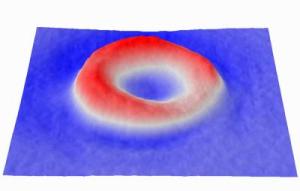Sep 8 2014
It may look like fresh blood and flow like fresh blood, but the longer blood is stored, the less it can carry oxygen into the tiny microcapillaries of the body, says a new study from University of Illinois researchers.
 This is the topography of a red blood cell as measured by the SLIM optical technique. Though the cell keeps its shape as it ages, the membrane becomes less flexible. Credit: Gabriel Popescu
This is the topography of a red blood cell as measured by the SLIM optical technique. Though the cell keeps its shape as it ages, the membrane becomes less flexible. Credit: Gabriel Popescu
Using advanced optical techniques, the researchers measured the stiffness of the membrane surrounding red blood cells over time. They found that, even though the cells retain their shape and hemoglobin content, the membranes get stiffer, which steadily decreases the cells' functionality.
Led by electrical and computer engineering professor Gabriel Popescu, the team published its results in the journal Scientific Reports.
"Our results show some surprising facts: Even though the blood looks good on the surface, its functionality is degrading steadily with time," said Popescu, who is also part of the Beckman Institute for Advanced Science and Technology at the U. of I.
Nearly 14 million units of blood are banked annually in the U.S. The established "shelf life" for blood in blood banks is 42 days. During that time, a lot of changes can happen to the blood cells – they can become damaged or rupture. But much of the blood keeps its shape and, by all appearances, looks like it did the day it was donated.
Popescu and his colleagues wanted to quantitatively measure blood cells over time to see what changed and what stayed the same, to help determine what effect older blood could have on a patient. They used a special optical technique called spatial light interference microscopy (SLIM), a method developed in Popescu's lab at Illinois in 2011. It uses light to noninvasively measure cell mass and topology with nanoscale accuracy. Through software and hardware advances, the SLIM system today acquires images almost 100 times faster than three years ago.
The researchers took time-lapse images of the cells, measuring and charting the cell's properties. In particular, they were able to measure nanometer scale motions of the cell membrane, which are indicative of the cell's stiffness and function. The fainter the membrane motion, the less functional the cell, much like how a fainter pulse indicates problems with a patient.
The measurements revealed that a lot of characteristics stay the same over time: The cells retain their shape, mass and hemoglobin content, for example. However, the membranes become stiffer and less elastic as time goes by. This is important because the blood cells need to be flexible enough to travel through tiny capillaries and permeable enough for oxygen to pass through.
"In microcirculation such as that in the brain, cells need to squeeze though very narrow capillaries to carry oxygen," said postdoctoral researcher Basanta Bhaduri, the lead author of the paper. "If they are not deformable enough, the oxygen transport is impeded to that particular organ and major clinical problems may arise. This is the reason why new red blood cells are produced continuously by the bone marrow, such that no cells older than 100 days or so exist in our circulation. "
The researchers hope that the SLIM imaging method will be used clinically to monitor stored blood before it is given to patients, since conventional white-light microscopes can be easily adapted for SLIM with a few extra components.
"These results can have a wide variety of clinical applications," said co-author Krishna Tangella, U. of I professor of pathology who is also affiliated with the Christie Clinic in Urbana, Illinois. "Functional data from red blood cells would help physicians determine when to give red-cell transfusions for patients with anemia. This study may help better utilization of red-cell transfusions, which will not only decrease healthcare costs but also increase the quality of care."